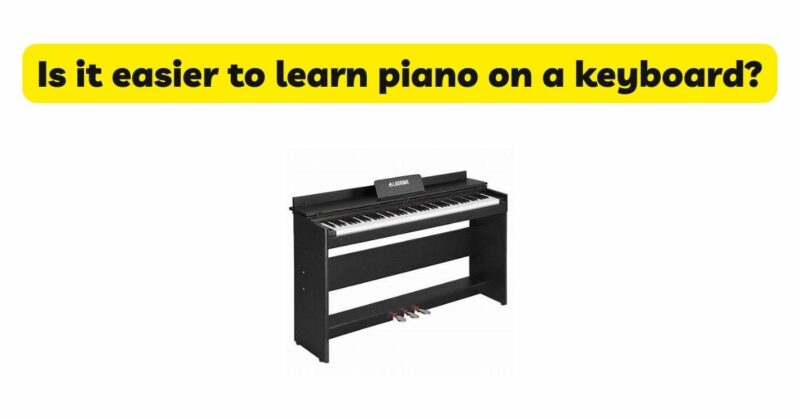Learning to play the piano is a fulfilling endeavor that requires dedication, practice, and the right approach. When it comes to choosing an instrument for piano learning, keyboards have emerged as a popular choice. In this article, we will delve into the advantages of learning piano on a keyboard and explore the reasons why it is often considered easier than traditional acoustic pianos. By understanding the benefits and unique features of keyboards, aspiring pianists can make an informed decision that suits their learning style, goals, and preferences.
- Accessibility and Convenience: One of the primary advantages of learning piano on a keyboard is its accessibility and convenience. Keyboards are compact, lightweight, and portable, allowing learners to practice anytime and anywhere. Unlike acoustic pianos, which are larger and require a dedicated space, keyboards can be easily stored and set up in any area of the home. This convenience ensures that learners have easy access to their instrument and can engage in regular practice without being restricted by space limitations or external factors.
- Affordability: Financial considerations play a significant role in the decision-making process for many aspiring pianists. Acoustic pianos can be costly, making them less accessible to individuals with limited budgets. Keyboards, on the other hand, are generally more affordable, with a wide range of options available to suit different price points. Entry-level keyboards offer the necessary features and functionalities for beginners without breaking the bank. The affordability factor makes keyboards an attractive choice for learners who want to embark on their piano journey without significant financial investment.
- Technological Advancements: Keyboards have made significant technological advancements, offering features that facilitate the learning process. Many keyboards now incorporate weighted keys and graded hammer action, which mimic the feel and touch sensitivity of an acoustic piano. This feature allows learners to develop proper finger strength and control. Moreover, keyboards often come equipped with built-in metronomes, recording capabilities, lesson modes, and interactive tutorials that guide learners through the learning process. These technological enhancements provide valuable tools and resources that support and enhance the learning experience.
- Sound Reproduction and Versatility: While acoustic pianos are renowned for their rich sound, keyboards have made impressive strides in sound reproduction. Advanced digital keyboards employ high-quality sound sampling technology to replicate the authentic sound of an acoustic piano. These sampled piano sounds, coupled with the versatility of keyboards, allow learners to explore a wide range of musical genres and styles. Additionally, keyboards often offer a variety of built-in instrument sounds, enabling learners to experiment with different tones and expand their musical horizons.
- Learning Resources and Interactive Features: Keyboards provide a wealth of learning resources and interactive features that make the learning process more engaging and enjoyable. Many keyboards come with built-in educational modes and tutorials specifically designed for beginners. These modes guide learners through step-by-step lessons, finger placement exercises, and music theory explanations. Additionally, keyboards can be connected to computers, tablets, or mobile devices, opening up a world of online tutorials, sheet music libraries, and interactive learning platforms. These resources provide comprehensive guidance and support, allowing learners to progress at their own pace.
- Customization and Accompaniment Options: Keyboards offer customization features that allow learners to adapt the instrument to their preferences and learning needs. They often provide adjustable touch sensitivity, allowing learners to tailor the keys’ response to their desired level. Keyboards also offer a range of accompaniment options, such as built-in rhythms, backing tracks, and automatic chord accompaniment. These features provide a dynamic and interactive learning environment, making it easier for learners to develop their sense of rhythm, timing, and musicality.
- Progress Tracking and Feedback: Many keyboards include features that allow learners to track their progress and receive immediate feedback. These features can include built-in recording capabilities, which allow learners to listen to their performance and identify areas for improvement. Some keyboards also offer visual indicators that highlight correct notes and finger placement during practice sessions. This real-time feedback helps learners develop accuracy, control, and self-awareness, making the learning process more efficient and effective.
Conclusion: Learning piano on a keyboard offers numerous advantages that make it an appealing and accessible option for aspiring pianists. The accessibility, affordability, technological advancements, sound reproduction, and interactive features of keyboards contribute to an easier and more enjoyable learning experience. While acoustic pianos possess their unique qualities and hold a special place in the world of music, keyboards provide a user-friendly platform that supports beginners and fosters their musical growth. Ultimately, the choice between learning piano on a keyboard or an acoustic piano should be based on individual preferences, goals, and resources. Regardless of the instrument chosen, what truly matters is the passion, dedication, and consistent practice that drive progress and proficiency in piano playing.


